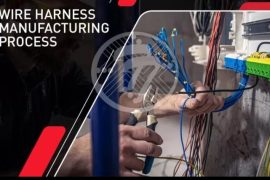Welcome to our latest blog post on wire harness manufacturing! Explore the enchanting transformation of intricate wire tangles into fully functional products as we guide you through the assembly process. Discover the meticulous craftsmanship and cutting-edge technology that shape these indispensable components. Whether you’re a curious individual or an industry insider, this post satisfies your thirst for knowledge, offering a newfound appreciation for the precision and skill in this often-overlooked discipline. So, relax and delve into the fascinating world of wire harness assembly process with us!
Introduction to Wire Harness Manufacturing
Wire harness manufacturing is a vital process that significantly impacts various industries by providing the essential network of wires for electronic devices. Found in automotive, aerospace, medical devices, and industrial automation, wire harnesses form the core of complex electrical systems. The manufacturing process involves design, engineering, and assembly, considering factors like voltage, current, and environmental conditions.
High-quality materials, including copper wires and insulation materials, are selected to ensure durability and optimal electrical performance. Computer-aided design software is used to create a 3D model, facilitating efficient fitting in confined spaces. Precision tasks such as cutting and stripping wires, termination processes like crimping or soldering, and rigorous testing procedures ensure quality control at every stage.
Advancements in technology, such as automated machines and computer-aided design, enhance efficiency. The importance of wire harnesses in various industries underscores their role in powering modern electronic systems, setting the stage for a more detailed exploration of the manufacturing process.
The Importance of Wire Harnesses in Various Industries
Wire harnesses play a vital role in connecting and powering electronic devices across various industries:
- Automotive: They ensure seamless communication between different vehicle components, enhancing safety and performance.
- Aerospace and Aviation: Wire harnesses power critical systems under extreme conditions, ensuring reliability in navigation, communication, and flight controls.
- Medical: In medical devices, wire harnesses enable precise connections for accurate diagnostics and treatments, prioritizing patient safety.
- Industrial Automation: These harnesses power automation components, streamlining manufacturing processes in industrial settings.
- Technology and Renewable Energy: They connect complex electrical infrastructure in smartphones and renewable energy solutions.
With technology advancements, custom wire harness solutions tailored to specific industry needs become essential for optimal performance and cost reduction. Wire harnesses are indispensable across industries, ensuring our modern world stays connected and powered.
Understanding the Design and Engineering Process
Design and engineering are critical stages in wire harness manufacturing, requiring meticulous planning to meet desired specifications:
- Understanding Requirements: Engineers consider voltage, current, temperature, and environmental conditions for the wire harness’s application.
- Schematic Diagram: A detailed diagram outlines component interconnections.
- Material Selection: Choose durable materials for insulation, conductor wires, connectors, terminals, and protective coverings that withstand harsh conditions and maintain electrical performance.
- 3D Visualization: Specialized software generates a 3D model, aiding in component fitting within tight spaces or complex geometries.
- Considerations: Engineers focus on signal integrity, electromagnetic interference susceptibility, and ease of assembly, making revisions as needed.
Understanding this design and engineering process is important for producing high-quality wire harnesses that meet industry standards and customer expectations.
Materials Used in Wire Harness Manufacturing
Material selection is important in wire harness assembly process manufacturing, impacting durability and reliability. High-quality materials enhance performance and extend the lifespan of wire harnesses:
- Copper: Excellent conductivity, corrosion resistance, and high-temperature tolerance make it ideal for transmitting electrical signals.
- Insulation Materials: Various options like PVC, Teflon, polyethylene, or silicone rubber protect and isolate wires, chosen based on temperature, flexibility, and chemical resistance.
- Connectors: Crucial for secure wire joining and electrical continuity, including crimp-on terminals, soldered terminals, and screw-type connectors.
- Protective Sleeves: Heat-shrinkable tubing or braided sleeving shields wires from environmental factors like moisture and dust.
Quality materials ensure wire harnesses meet industry standards, perform reliably, and endure challenging conditions.
Steps Involved in the Manufacturing Process
In the wire harness assembly process, several important steps are followed to ensure the final product meets the required specifications and functions optimally:
- Design and Engineering: Collaboration with clients helps understand specific needs, leading to the creation of a detailed plan for the wire harness assembly process, specifying wires, connectors, and terminals.
- Material Procurement: High-quality materials like copper wires, connectors, insulating tapes, and heat shrink tubing are sourced from reliable suppliers. Rigorous inspections ensure material integrity.
- Wire Cutting and Stripping: Specialized machines cut wires to precise lengths and remove insulation, ensuring perfect connectivity during assembly.
- Termination: Connectors are securely attached to one end of each wire through crimping or soldering, establishing strong connections between components.
- Assembly: Wires are organized according to the design plan, using bundling techniques to prevent tangling during installation.
- Quality Control: Stringent checks are conducted at each stage to detect defects. This includes continuity testing for electrical conductivity and visual inspections for overall functionality.
By following these steps diligently, wire harness manufacturers can deliver high-quality products that meet industry standards and perform efficiently in various applications.
Quality Control and Testing Procedures
The wire harness assembly process prioritizes Quality Control and Testing Procedures to ensure the highest standards of quality and performance in the final product. This involves:
- Quality Control: Thorough inspection of each component to detect defects, including checking crimping, soldering, and insulation for potential electrical issues.
- Testing Procedures: Rigorous tests for functionality and durability, including stress tests like extreme temperature, vibration, and moisture exposure to ensure resilience.
- Electrical Testing: Verification of secure and proper connections to prevent electrical failures, with automation for precision.
These measures guarantee reliable wire harnesses that meet customer specifications and industry regulations, ensuring optimal performance and longevity across various applications, including automotive, aerospace, medical devices, and telecommunications.
Advancements in Wire Harness Manufacturing Technology
Technological advancements have transformed wire harness assembly process manufacturing:
- Computer-Aided Design (CAD): Engineers use CAD software for precise and efficient wire harness designs, saving time and ensuring accuracy.
- Automated Cutting and Stripping: Machines cut wires accurately to length and strip them, reducing errors and speeding up production.
- Crimping Machines: Ensure secure crimps for reliable electrical connections with consistent pressure.
- Improved Insulation: Advanced materials protect against environmental factors, with heat-shrink tubing offering enhanced durability and moisture protection.
- Automated Testing: High-tech equipment checks individual connections for continuity and functionality before final assembly.
- Automation: Robotic arms aid in routing wires and securing cable ties with speed and precision.
These advancements enhance efficiency and maintain high-quality standards in wire harness manufacturing across industries.
Common Challenges and Solutions in Wire Harness Production
Wire harness production can be complex, but innovative solutions have emerged to address challenges:
- Complex Designs: Increasing wire and component complexity is managed with 3D CAD models, aiding in organization, visualization, and optimization of routing paths.
- Connectivity and Electrical Performance: Rigorous testing, including automated checks and specialized tools like crimping machines, ensures reliable connections and electrical performance.
- Consistency in Quality: Strict quality control measures, including material inspections, manufacturing audits, and final product checks, maintain quality across large-scale production.
These solutions enhance production efficiency and guarantee reliable, high-quality wire harnesses for various industries, ensuring safety and reliability in the final products.
Net worth overview: A measure of financial health, calculated by subtracting total liabilities from assets, reflecting one’s financial position and guiding sound financial decisions.
Conclusion
In the ever-evolving landscape of technology, wire harnesses emerge as indispensable components across automotive, aerospace, medical devices, and electronics, serving as the linchpin in intricate electrical systems. This conclusion encapsulates our journey through the design, engineering, materials, and quality control aspects of wire harness assembly process manufacturing. Technological strides, particularly in automation, have reshaped production dynamics, ensuring heightened efficiency and precision.
However, persistent challenges underscore the need for adept problem-solving skills. The wire harness retains its pivotal role in seamless electrical connectivity, with ongoing advancements anticipated in both design and manufacturing. As you power up your car or electronic device, take a moment to acknowledge the unsung hero – the meticulously crafted wire harness that facilitates our modern way of life!



